Rattlers remain awesome despite frequent persecution from humans.
Imagine you are out on a warm, breezy spring afternoon, climbing through dense chaparral deep in the Los Padres National Forest in California. You’ve been searching for hours through rocks and crevices, trying to find the elusive California mountain kingsnake (Lampropeltis zonata), when all of a sudden you hear that loud characteristic sound, tsssst, tsssssst, tsssssssssssssssst!
What goes though your mind next is a scattershot of emotions: excitement, because you feel like a school kid knowing there is a snake nearby; fear, as in, Oh crap, it’s a southern Pacific rattlesnake! Where the hell is it? followed by absolute joy when you are spot the rattler hiding below the ledge you are standing on, where it is nowhere near within striking distance.
Most avid field herpers have encountered a similar situation, whether they are hunting for a specific rattlesnake or another species entirely. You always know a rattlesnake is probably nearby.
Rattlesnakes are some of the most unique and diverse American reptiles. There are currently 32 different species of rattlesnakes, with approximately 83 subspecies that are broken down into the two genera Crotalus and Sistrurus. Such diversity exists between both groups of rattlesnakes because they are able to inhabit a wide variety of habitats, allowing for speciation to occur. This article will focus on some brief natural history of some of the more unique rattlesnake species in North America. For further reading, I recommend The Biology of Rattlesnakes by Hayens et al., Rubio’s Rattlesnakes of North America and Canada and Ernst’s Venomous Reptiles of the United States, Canada, and Northern Mexico.
But now, let’s take a look at 11 of the more interesting North American rattlers.
Timber/Canebrake Rattlesnake
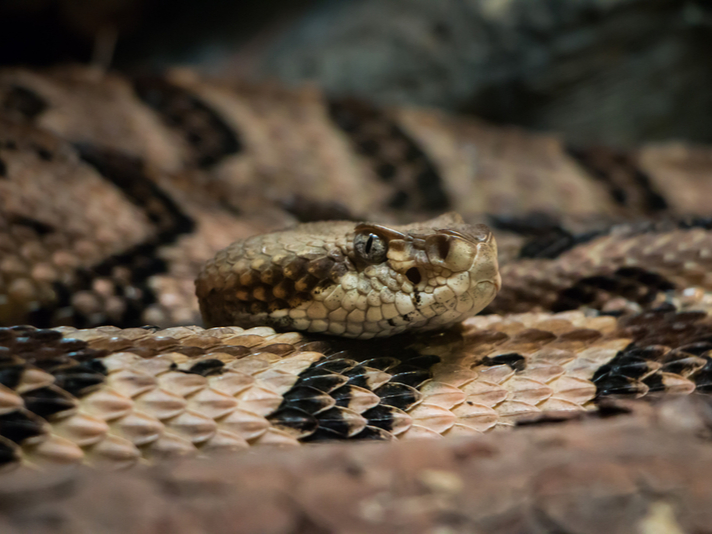
Dennis Riabchenko/Shutterstock
Timber rattlesnakes are some of the more passive and slow-moving species of rattlesnakes.
These used to be classified into two subspecies—the timber rattlesnake (Crotalus horridus horridus) and the canebrake (C. h. atricaudatus)—until scientists discovered that the two subspecies nearly had the same genetic structure. However, many individuals believe that the canebrake and the timber are two distinct species based off of clear morphological differences.
Both are heavy-bodied, medium to large rattlesnakes. Their dorsal patterning includes dark chevrons with light edging scales. The chevrons darken as they reach the tail.
These are some of the more passive and slow-moving species of rattlesnakes. Often they will not even rattle unless they are disturbed continuously. Their cryptic pattern allows them to blend exceptionally well with the vegetated ground cover. Timber (and canebrake) rattlers often remain undetected while buried in fallen leaves or grass with only their heads exposed.
In the eastern U.S., the timber rattlesnake inhabits exclusively mountainous highlands consisting of deciduous forests, meadows and rocky hillsides. Although not an aquatic species, canebrakes occupy wetter environments along waterways, swamps and bogs within hardwood forests. In the southern U.S., they frequently are found in tall grasses related to bamboo, the reason for their common name.
Populations of both species are thought to be in rapid decline, and they are protected in some regions. Threats include habitat destruction, human development, agriculture, commercial collecting and unwarranted killing. Recently, the emerging infectious disease known as snake fungal disease (Ophidiomyces ophiodiicola) was described in a population of timber rattlesnakes, making this emerging infectious disease a concern to the species’ conservation status.
Eastern Diamondback
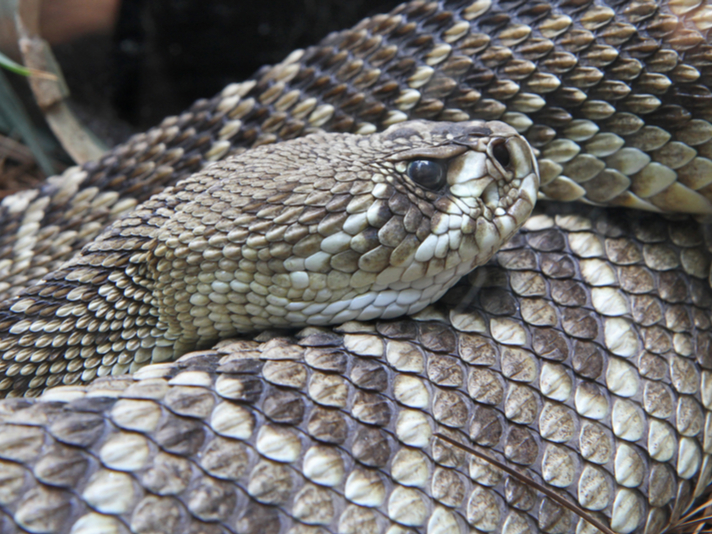
Kevin M. McCarthy/Shutterstock
Eastern diamondbacks typically feed on small mammals or quail.
Averaging about 5 feet in length but with reports of specimens up to 8 feet, the eastern diamondback (C. adamateus) is the second longest rattlesnake and most heavily bodied in the U.S. It has the most distinct pattern of all the North American rattlesnakes, and the dark dorsal diamond pattern allows eastern diamondbacks to blend into their habitat extremely well. Being an ambush predator, the eastern diamondback relies heavily on this camouflage.
Its range includes the coastal plain of the southeastern U.S., where specimens can typically be found in habitats containing two niches. First, eastern diamondbacks cohabitate with the gopher tortoise (Gopherus polyphemus), utilizing tortoise burrows for shelter during hibernation, birthing and predator evasion. Secondly, rotting wood stumps provide shelter for these animals through a network of root systems as a series of tunnels.
Eastern diamondbacks typically feed on small mammals or quail. Few animals are predators to an adult eastern diamondback; however, bobcats, raptors, feral pigs and other snakes such as kingsnakes can consume the young animals.
Western Diamondback
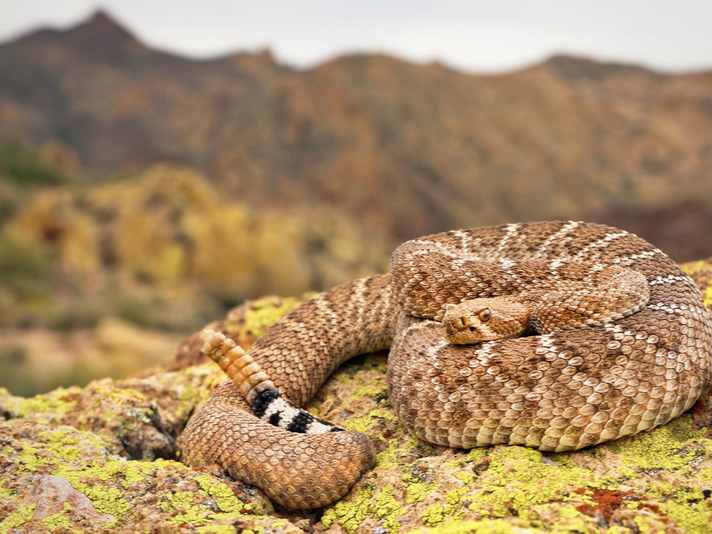
Ryan M. Bolton/Shutterstock
Western diamondback rattlesnakes inhabit a wide variety of habitats because they are ecological generalists.
The western diamondback rattlesnake (C. atrox) is the longest rattlesnake found within the United States, with the largest one ever recorded being 8.5 feet in length. On average they range from 3.5 to 4.5 feet. Like the eastern diamondback, it has a distinct diamond dorsal pattern; however, the western diamondback’s pattern is much lighter than the darker eastern diamondback’s. Colors can range from light tan to red depending on habitat. One distinct feature of these snakes are the four to six alternating black and white bands that are present before the tail turns into a rattle.
When provoked, the western diamondback exhibits a brilliant anti-predator display, rattling consistently with a characteristic raised S-shaped coil, with body cocked and ready to strike. The western diamondback is responsible for envenomating more people than any other rattlesnake species in the U.S.
Western diamondback rattlesnakes inhabit a wide variety of habitats because they are ecological generalists. They can be found in environments ranging from flat, arid regions of the southwest U.S. to mountainous rocky environments. In the wild, young western diamondbacks are vulnerable to predation by birds of prey, other snakes, roadrunners and carnivorous mammals. Humans are a threat, too, due to habitat destruction for human development, which also results in increased interaction between humans and western diamondbacks. Additionally, events such as rattlesnake roundups have contributed to population declines and local population extinctions due to excessive harvesting and hunting.
Approximately 125,000 western diamondback rattlesnakes are harvested each year to be killed during sensationalistic displays and events at rattlesnake roundups. It is widely believed that roundups have played a significant role in population declines of this species, especially in Oklahoma. The events often operate under the premise that they are educational to the public, while it is well known that roundups do not encourage positive attitudes toward rattlesnake conservation, but rather significantly hinder rattlesnake conservation.
Mojave Rattlesnake
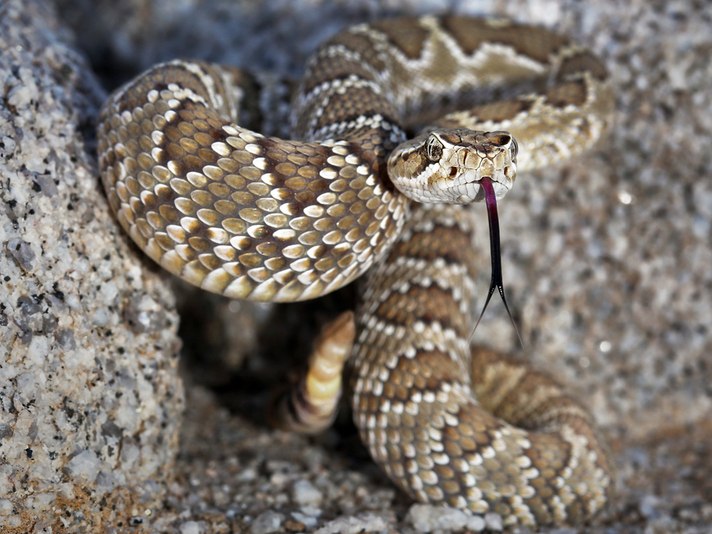
Ryan M. Bolton/shutterstock
If envenomation from a Mojave rattlesnake occurs it is considered a serious medical emergency.
The Mojave rattlesnake (C. scutulatus) is commonly mistaken for the western diamondback rattlesnake because the ranges of the two snakes overlap considerably. Also, Mojave rattlesnakes also possess the diamond dorsal patterning similar to the eastern and western diamondbacks, with coloration that ranges from brownish to a muted green.
Two distinguishing characteristics separate it from the western diamondback: tail banding pattern and the position of the facial stripes. The Mojave rattlesnake usually has two to eight alternating black and white bands of scales prior to the rattle, with the top segment being black. Black bands are typically narrower than the white bands. As for the facial stripes, Mojave rattlesnakes possess two white facial stripes that run diagonally backward from the eye to the mouth scales. The first stripe starts at the front of the eye and the second stripe ends beyond the angle of the jaw.
If envenomation from a Mojave rattlesnake occurs it is considered a serious medical emergency. Populations of this species extend from California to Texas in the southwestern U.S., and different populations have different venom compositions. Venom experts have divided Mojave rattlesnakes into two groupings based on their venom composition and properties. Type A animals posses the “Mojave toxin” which is a potent neurotoxin, and Type B animals possess primarily potent hemotoxic venom.
Some Mojave rattlesnake populations in central and southern Arizona have both venom types, producing an extremely potent mix of hemotoxic and neurotoxic reactions in the body upon envenomation that can be extremely life threatening.
Western Rattlesnakes
The western rattlesnakes encompass five different subspecies: the southern Pacific rattlesnake (C. oreganus helleri), the northern Pacific (C. o. oreganus), the Grand Canyon rattlesnake (C. o. abyssus), midget faded rattlesnake (C. o. concolor) and the Great Basin rattlesnake (C. o. lutosus). At one time it was believed these snakes were all related to the prairie rattlesnake (C. viridis), and many have similar dorsal markings and facial striping which sometimes makes them difficult to decipher. However, knowing their ranges and intergrade zones makes it easy to identify them.
The western rattlesnakes thrive in many habitats, from conifer woods to vegetated coastal areas, and they can be found at elevations ranging from sea level up to to 9,000 feet. They are expansive from Mexico to Canada and west of the Continental Divide. The southern and northern Pacific rattlesnakes commonly intergrade along the central coast of California.
The C. oreganus group is popular within the venomous pet trade because of the high amount of color variation that can be found among the snakes, including amelanistic, albino, patternless and axanthic phenotypes.
Pygmy Rattlesnakes
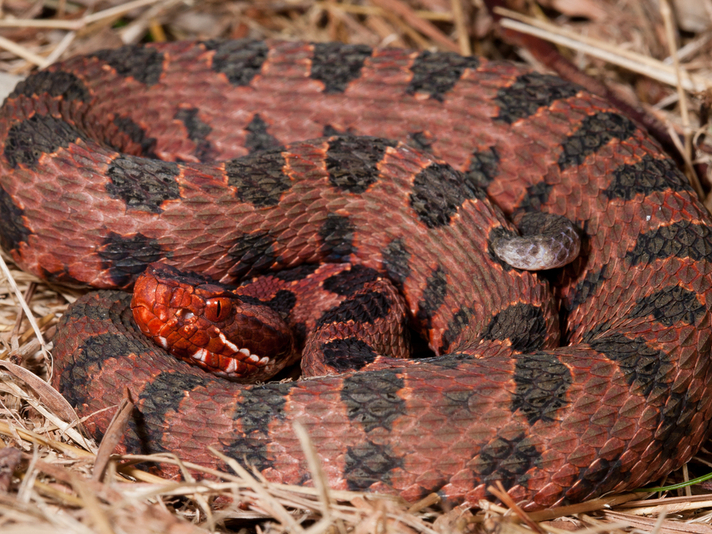
Nashepard/Shutterstock
Pygmy rattlesnakes exhibit a wide variety of coloration.
Pygmy rattlesnakes (Sistrurus miliarius miliarius, S. m. barbouri, S. m. streckeri) range from the southeastern U.S. to as far west as eastern Texas. Overlapping species of pygmies integrade. They inhabit several different habitats including pinewoods, hardwoods, palmetto, adjacent to marshes, wet prairies, pine flatwoods and dry river bottoms. They can often be found among logs, rocks, woodpiles, junk piles and in open grass where prey items are plentiful.
Pygmy rattlesnakes exhibit a wide variety of coloration; some populations are known for their orange to red coloration while others are very dark, almost black to patternless.
Eastern Massasauga
The eastern massasauga (S. catenatus catenatus)was recently proposed to be listed as threatened by the U.S. Fish and Wildlife service. It is a small, thick-bodied rattlesnake that inhabits shallow wetlands in portions of Illinois, Indiana, Iowa, Michigan, Minnesota, New York, Ohio, Pennsylvania, Wisconsin and Ontario, Canada (it’s one of only three rattlesnake species to inhabit Canada). It displays a dorsal pattern of black or very dark brown oval-shaped blotches on a gray or reddish-brown background.
Major contributing factors to the eastern massasauga’s population decline are habitat destruction, farming, and weather pattern changes. Snake fungal disease also has recently been documented in some populations.
In the northeastern U.S., there has been one documented case of the eastern massasauga reproducing with a timber rattlesnake, creating a hybrid intergrade.
Sidewinder
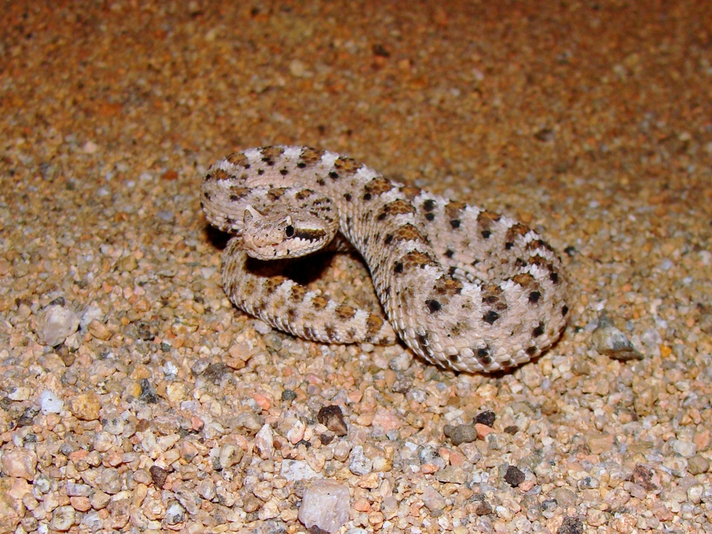
Matt Jeppson/Shutterstock
The sidewinder (C. cerastes) is a small desert species of rattlesnake that thrives in hot, sandy, barren deserts of the American southwest.
The sidewinder (C. cerastes) is a small desert species of rattlesnake that thrives in hot, sandy, barren deserts of the American southwest. They possess the ability to move forward just like any snake; however, it is well-known for its ability to crawl sideways for long periods of time while moving across massive sand dunes.
The evolution of “sidewinding” as a form of locomotion in snakes is an adaptation to handle hot surface temperatures. It prevents absorption of heat because the highly coordinated movements elevate all but two small sections of the snake’s body above the surface at any given time. Allowing two points of contact prevents excessive absorption of heat from the earth’s surface. Characteristic J- shaped marks follow a diagonal course when this form of locomotion is employed, making the tracking of sidewinders on dunes quite easy.
Sidewinders have two distinct physical characteristics that make them easily identifiable. They have a spinal ridge that runs along the length of their spine, as well as a modified supraocular scale that resembles a horn over each eye.
Sidewinders can often be found partially buried after using a technique called “cratering,” in which a snake flattens its body while coiled in the sand to hide and facilitate the ambush of prey. Like most other rattlesnakes, sidewinders are ambush predators and typically consume lizards and small rodents.
Banded Rock Rattlesnake
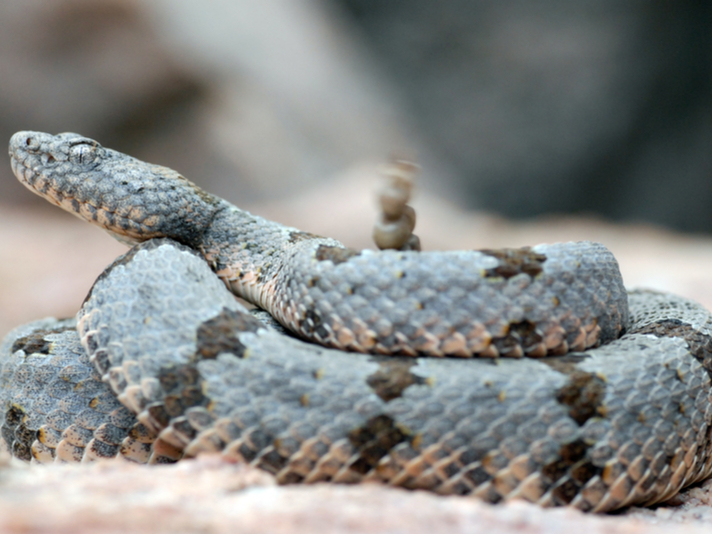
Jason Mintzer/Shutterstock
The banded rock rattlesnake (C. lepidus klauberi) is one of the smaller rattlesnakes in the U.S., rarely achieving lengths longer than 2 feet.
The banded rock rattlesnake (C. lepidus klauberi) is one of the smaller rattlesnakes in the U.S., rarely achieving lengths longer than 2 feet. With a spotty distribution in the American southwest, it can be found inhabiting mountain ranges along the Mexican border in Texas, New Mexico and Arizona (they have a wider distribution in the mountains of Mexico compared to the U.S).
Banded rock rattlesnakes are very cryptic in nature and not commonly observed because of their coloration, small size and speed. They typically inhabit elevations of 5,000 to 8,000 feet in open rockslides, rocky outcrops and rocky areas in pine-oak and conifer forest habitats.
Ridge-Nosed Rattlesnakes
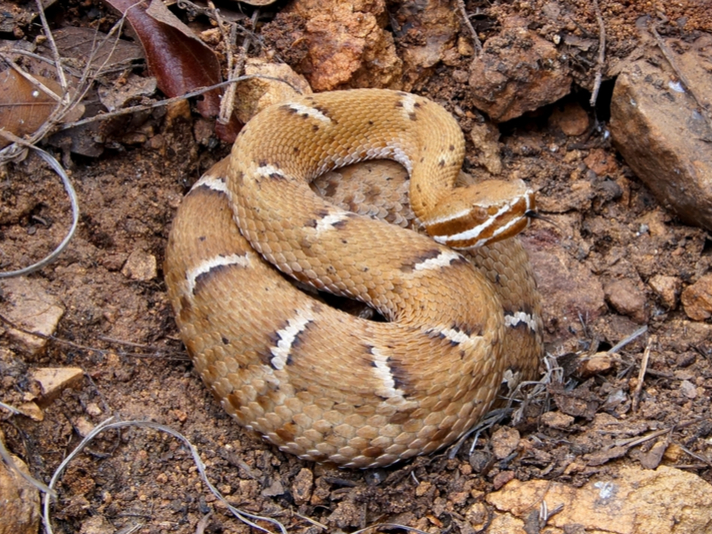
Matt Jeppson/Shutterstock
The Arizona (C. willardi willardi) and New Mexico (C. w. obscurus) ridge-nosed rattlesnakes are extremely similar, with the exception of dorsal patterning and distribution.
The Arizona (C. willardi willardi) and New Mexico (C. w. obscurus) ridge-nosed rattlesnakes are extremely similar, with the exception of dorsal patterning and distribution. They both possess a raised rostrum that forms a distinct upturned ridge from which their common name is derived.
The Arizona form is reddish brown with small, randomly distributed dark scaling. The pattern consists of broken, light-colored crossbars bordered by dark brown to black scales. The New Mexico ridge nose is pale gray to tan with poorly defined darker crossbars. The head is patternless, and the face does not have the dominant stripes that define the Arizona form.
The entire U.S. population of willardi can be found in a few canyons off the Huachuca, Santa Rita, Patagonia and Whetstone mountains in Arizona, while the obscurus distribution in New Mexico is much more limited to the Peloncillo and Animas mountains.
Both snakes survive at high altitudes and inhabit rocky places in pine-oak and conifer woodlands. Few envenomations have been reported with either, and their venom has a low toxicity.
Twin-Spotted Rattlesnake
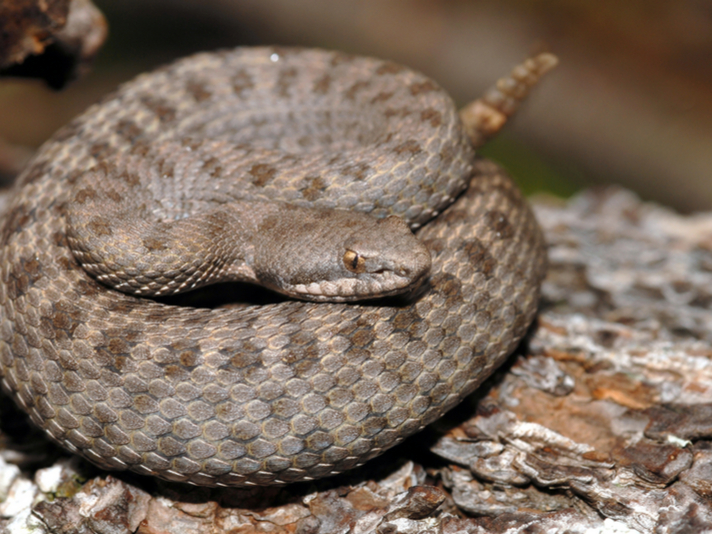
Rusty Dodson/Shutterstock
There are scant reports of human envenomations by the twin-spotted rattlesnake, and no fatalities known.
The twin-spotted rattlesnake (C. pricei pricei) is the smallest rattlesnake in the U.S., and it often appears to be in poor condition when observed in the wild. The largest specimen observed to date was only 26 inches long. Its range includes the Chiricahua, Huachuca, Santa Rita and Pinaleno mountains of southeast Arizona, where it is typically found among rock slides and hardwood and conifer forests at elevations higher than 6,000 feet. There are scant reports of human envenomations, and no fatalities known.
Safety Tips for Keepers
Only experienced keepers should maintain rattlesnakes. Direct contact should be kept to an absolute minimum, and proper tools must be employed when interacting with them. If one decides to keep rattlesnakes, it is also vital that the type of venom the snake(s) possess be determined. Rattlesnake venom can be highly variable based on the species. For example, populations of the Mojave rattlesnake posses a primarily neurotoxic venom (Mojave toxin) while some species in the same range, such as the sidewinder and speckled rattlesnake (C. mitchellii), possess a primarily hemotoxic or myotoxic venom.
For people interested in gaining more experience in working with rattlesnakes, I recommend first gaining experience in a zoological institution with experienced venomous keepers, or developing a relationship with someone who has experience with keeping rattlesnakes legally. Rattlesnakes can be extremely unpredictable to the untrained individual. Training allows keepers to understand the animals’ behaviors and teaches them how to “read” an animal in order to anticipate its movements, and whether it will try and strike.
Successful rattlesnake keepers tend to interact minimally—when feeding and cleaning only—with their rattlesnakes. Tools employed to interact and move the snakes successfully include a combination of hooks and tongs. Ideally, two people should be present when interacting with venomous reptiles, including rattlesnakes. Any cage housing a venomous snake should be opened only with a tool and never by hand.
Rattlesnakes can be moved into a large trashcan or 5-gallon bucket (depending on the size of the snake) using an appropriately sized hook or tongs. The container should have a secure, easily sealed lid for temporary confinement. “Shift boxes” can be used successfully to prevent any interaction; however, these are more difficult to use with pit viper species such as rattlesnakes compared to dealing with elapids.
These methods to remove animals from their enclosures will allow keepers to clean the enclosures. To assist in feeding, long hemostats or tongs can be used to place and remove food items within cages.
Keeping rattlesnakes is a potentially life-threatening decision. Any time the door to an enclosure containing a rattlesnake is opened, you are at risk of being bitten.
Rattlesnake Envenomation
People are bitten trying to kill, catch or handle rattlesnakes, and approximately 7,000 to 8,000 snake envenomations occur within the United States and Canada annually, with a large percentage caused by rattlesnakes. Medical attention should be sought immediately if envenomation is suspected.
Any rattlesnake bite could be life threatening, and the person who has been bitten should be transported to a hospital by paramedics to establish initial therapeutics. Delaying the pursuit of treatment for a rattlesnake envenomation is irresponsible. No one should ever hesitate to seek medical attention for a rattlesnake envenomation, even if the person bitten is keeping rattlesnakes illegally (though doing so is not recommended, of course). Your life is more important than worrying whether or not your animals get confiscated.
The first steps for successful first aid of a rattlesnake bite is getting to the nearest emergency facility; removing anything that could cause constriction on the body, such as rings, watches and other items; and keeping the bitten appendage below the plane of the heart.
Many myths exist regarding the treatment of venomous snake bites. Immediate treatment options that should not be performed include tourniquet application, sucking out venom by mouth, or cutting the envenomation site first and then sucking the venom. Venom extractors are of little use and not recommended, either.
Envenomation severity depends on several factors, including time elapsed prior to treatment, the snake species, venom properties and quantity of venom injected, number of times bitten, the victim’s age, size, physical condition and response to venom. Fang penetration is not necessary for envenomation—any break in a person’s skin through which venom penetrates can cause clinical signs of envenomation.
Keep it Legal
Venomous laws vary between states. Prior to keeping any rattlesnakes, please contact your local government organization that regulates wildlife (e.g., the California Department of Fish and Wildlife, Florida Fish and Wildlife, etc.) to determine first if it’s legal, and if so, to learn the proper avenues necessary for you to become a legal keeper of rattlesnakes.
It is your responsibility as a keeper to obtain and possess these beautiful animals within the guidelines of the law. Doing so illegally only provides more justification for organizations such as People for the Ethical Treatment of Animals (PETA) and the Humane Society of the United States (HSUS) to try and restrict our rights to keep these amazing species.
Sean M. PERRY, DVM, is a veterinarian working at the University of Illinois College of Veterinary Medicine, with a special interest in reptile medicine and surgery. His research interests include evaluating artificial reproductive technologies in reptile species and advancing emergency and critical care medicine in reptiles.



